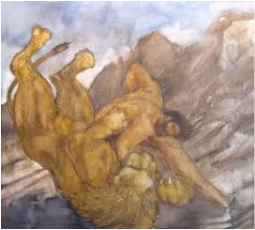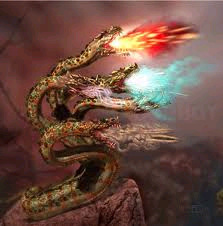The Great Labors of Hercules
THE LION

Hercule said to wait 30 day if Hercule returned with the lions skin they would scacrifce to zues. If Hercules died tring to kill the lion, Molorchus agreed to sacrifice instead to Hercules. Hercules blocked one of the door ways. Hercule avoided the lions claws he grabed the lions neck and held it tightlyso he would choked to death.
"Hercules returned to Cleonae, carrying the dead lion, and found Molorchus on the 30th day after he'd left for the hunt. Instead of sacrificing to Hercules as a dead man, Molorchus and Hercules were able to sacrifice together, to Zeus. When Hercules made it back to Mycenae, Eurystheus was amazed that the hero had managed such an impossible task. The king became afraid of Hercules, and forbade him from entering through the gates of the city. Furthermore, Eurystheus had a large bronze jar made and buried partway in the earth, where he could hide from Hercules if need be. After that, Eurystheus sent his commands to Hercules through a herald, refusing to see the powerful hero face to face
Many times we can identify Hercules in ancient Greek vase paintings or sculptures simply because he is depicted wearing a lion skin. Ancient writers disagreed as to whether the skin Hercules wore was that of the Nemean lion, or one from a different lion, which Hercules was said to have killed when he was 18 years old. The playwright Euripides wrote that Hercules' lion skin came from the grove of Zeus, the sanctuary at Nemea."
(http://www.perseus.tufts.edu/Herakles/lion.html)
"Hercules returned to Cleonae, carrying the dead lion, and found Molorchus on the 30th day after he'd left for the hunt. Instead of sacrificing to Hercules as a dead man, Molorchus and Hercules were able to sacrifice together, to Zeus. When Hercules made it back to Mycenae, Eurystheus was amazed that the hero had managed such an impossible task. The king became afraid of Hercules, and forbade him from entering through the gates of the city. Furthermore, Eurystheus had a large bronze jar made and buried partway in the earth, where he could hide from Hercules if need be. After that, Eurystheus sent his commands to Hercules through a herald, refusing to see the powerful hero face to face
Many times we can identify Hercules in ancient Greek vase paintings or sculptures simply because he is depicted wearing a lion skin. Ancient writers disagreed as to whether the skin Hercules wore was that of the Nemean lion, or one from a different lion, which Hercules was said to have killed when he was 18 years old. The playwright Euripides wrote that Hercules' lion skin came from the grove of Zeus, the sanctuary at Nemea."
(http://www.perseus.tufts.edu/Herakles/lion.html)
The Lernean Hydra

The second labor of Hercules was to kill the Lernean Hydra.
"Hercules set off to hunt the nine-headed menace, but he did not go alone. His trusty nephew, Iolaus, was by his side. Iolaus, who shared many adventures with Hercules, accompanied him on many of the twelve labors. Legend has it that Iolaus won a victory in chariot racing at the Olympics and he is often depicted as Hercules' charioteer. So, the pair drove to Lerna and by the springs of Amymone, they discovered the lair of the loathsome hydra.
First, Hercules lured the coily creature from the safety of its den by shooting flaming arrows at it. Once the hydra emerged, Hercules seized it. The monster was not so easily overcome, though, for it wound one of its coils around Hercules' foot and made it impossible for the hero to escape. With his club, Hercules attacked the many heads of the hydra, but as soon as he smashed one head, two more would burst forth in its place! To make matters worse, the hydra had a friend of its own: a huge crab began biting the trapped foot of Hercules. Quickly disposing of this nuisance, most likely with a swift bash of his club, Hercules called on Iolaus to help him out of this tricky situation. Each time Hercules bashed one of the hydra's heads, Iolaus held a torch to the headless tendons of the neck. The flames prevented the growth of replacement heads, and finally, Hercules had the better of the beast. Once he had removed and destroyed the eight mortal heads, Hercules chopped off the ninth, immortal head. This he buried at the side of the road leading from Lerna to Elaeus, and for good measure, he covered it with a heavy rock. As for the rest of the hapless hydra, Hercules slit open the corpse and dipped his arrows in the venomous blood.Eurystheus was not impressed with Hercules' feat, however. He said that since Iolaus had helped his uncle, this labor should not count as one of the ten. This technicality didn't seem to matter much to anyone else: the ancient authors still give Hercules all of the credit. Even so, Pausanias did not think that this labor was as fantastic as the myths made it out to be: to him, the fearsome hydra was just, well, a big water snake."
(http://www.perseus.tufts.edu/Herakles/hind.html)
The Hind of Ceryneia Diana's Pet Deer

(You can see Hercules in the backround a little)
"For the third labor, Eurystheus ordered Hercules to bring him the Hind of Ceryneia. Now, before we go any further, we'll have to answer two questions: What is a hind? and, Where is Ceryneia? Ceryneia is a town in Greece, about fifty miles from Eurystheus' palace in Mycenae. A hind is simply a female red deer.
You'd think it would have been easy for a hero like Hercules to go shoot a deer and bring it back to Eurystheus, but a few problems made things complicated. This was a special deer, because it had golden horns and hoofs of bronze. Not only that, the deer was sacred to the goddess of hunting and the moon, Diana; she was Diana's special pet. That meant that Hercules could neither kill the deer nor hurt her. He couldn't risk getting Diana angry at him; he was already in enough trouble with Hera. Hercules set out on this adventure, and he hunted the deer for a whole year. At last, when the deer had become weary with the chase, she looked for a place to rest on a mountain called Artemisius, and then made her way to the river Ladon. Realizing that the deer was about to get away, Hercules shot her just as she was about to cross the stream. He caught the deer, put her on his shoulders and turned back to Mycenae. As Hercules hurried on his way, he was met by Diana and Apollo. Diana was very angry because Hercules tried to kill her sacred animal. She was about to take the deer away from Hercules, and surely she would have punished him, but Hercules told her the truth. He said that he had to obey the oracle and do the labors Eurystheus had given him. Diana let go of her anger and healed the deer's wound. Hercules carried it alive to Mycenae."
(http://www.perseus.tufts.edu/Herakles/hind.html)
"For the third labor, Eurystheus ordered Hercules to bring him the Hind of Ceryneia. Now, before we go any further, we'll have to answer two questions: What is a hind? and, Where is Ceryneia? Ceryneia is a town in Greece, about fifty miles from Eurystheus' palace in Mycenae. A hind is simply a female red deer.
You'd think it would have been easy for a hero like Hercules to go shoot a deer and bring it back to Eurystheus, but a few problems made things complicated. This was a special deer, because it had golden horns and hoofs of bronze. Not only that, the deer was sacred to the goddess of hunting and the moon, Diana; she was Diana's special pet. That meant that Hercules could neither kill the deer nor hurt her. He couldn't risk getting Diana angry at him; he was already in enough trouble with Hera. Hercules set out on this adventure, and he hunted the deer for a whole year. At last, when the deer had become weary with the chase, she looked for a place to rest on a mountain called Artemisius, and then made her way to the river Ladon. Realizing that the deer was about to get away, Hercules shot her just as she was about to cross the stream. He caught the deer, put her on his shoulders and turned back to Mycenae. As Hercules hurried on his way, he was met by Diana and Apollo. Diana was very angry because Hercules tried to kill her sacred animal. She was about to take the deer away from Hercules, and surely she would have punished him, but Hercules told her the truth. He said that he had to obey the oracle and do the labors Eurystheus had given him. Diana let go of her anger and healed the deer's wound. Hercules carried it alive to Mycenae."
(http://www.perseus.tufts.edu/Herakles/hind.html)
